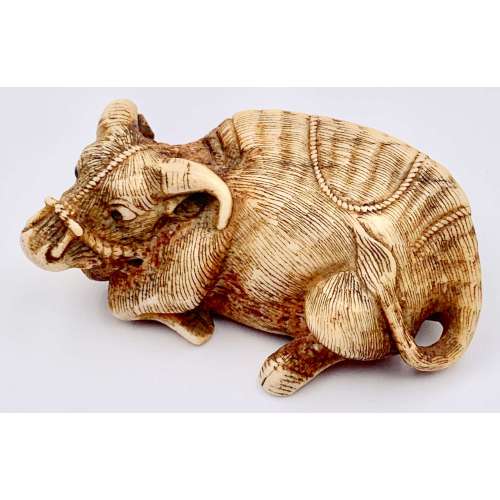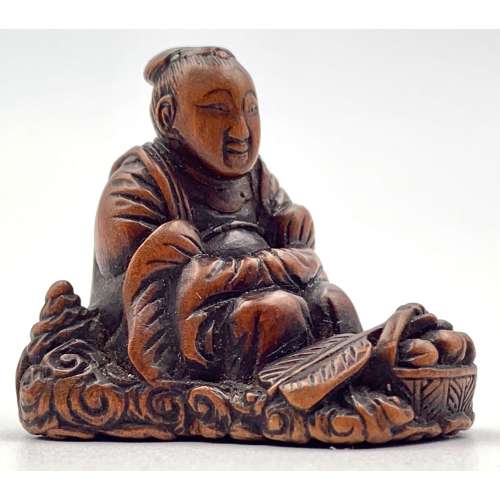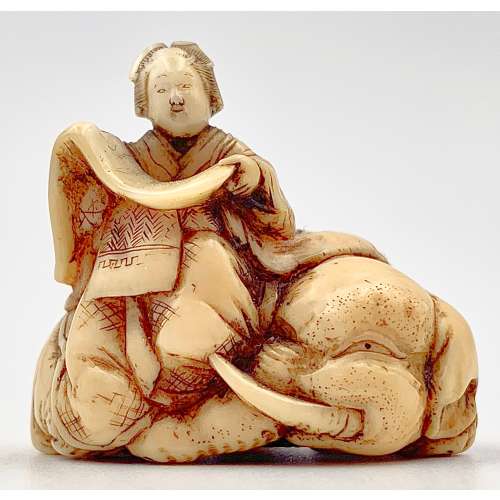-
 Stag antler netsuke of a recumbent ox. Signed: Tomomasa [友政]. Circa 1800. Dimensions: 56.1 x 20.7 x 36.8 mm Just speculation: There was a master in Kyoto named Tomotada who made netsuke with a recumbent ox motif. Our Tomomasa may be an epigone of a later date. Some even attribute the master to Meiji period. Provenance: Charles Ephrussi (1849-1905) acquired in the 1870s; a wedding gift in 1898 to his cousin Ritter Viktor von Ephrussi (1860-1945) and Baroness Emilie (Emmy) Schey von Koromla (1879-1938); retrieved post-war by their daughter Elizabeth de Waal (1899-1991); given by her to her brother Ignaz (Iggie) Ephrussi (1906-1994), Tokyo; bequeathed by him to his great-nephew Edmund de Waal (born 1964), London, author of “The Hare with Amber Eyes: a hidden inheritance”. London / New York: Chatto & Windus / Farrar, Straus & Giroux. ISBN 978-0099539551. https://en.wikipedia.org/wiki/Charles_Ephrussi. https://en.wikipedia.org/wiki/Ephrussi_family. https://en.wikipedia.org/wiki/Edmund_de_Waal.
Stag antler netsuke of a recumbent ox. Signed: Tomomasa [友政]. Circa 1800. Dimensions: 56.1 x 20.7 x 36.8 mm Just speculation: There was a master in Kyoto named Tomotada who made netsuke with a recumbent ox motif. Our Tomomasa may be an epigone of a later date. Some even attribute the master to Meiji period. Provenance: Charles Ephrussi (1849-1905) acquired in the 1870s; a wedding gift in 1898 to his cousin Ritter Viktor von Ephrussi (1860-1945) and Baroness Emilie (Emmy) Schey von Koromla (1879-1938); retrieved post-war by their daughter Elizabeth de Waal (1899-1991); given by her to her brother Ignaz (Iggie) Ephrussi (1906-1994), Tokyo; bequeathed by him to his great-nephew Edmund de Waal (born 1964), London, author of “The Hare with Amber Eyes: a hidden inheritance”. London / New York: Chatto & Windus / Farrar, Straus & Giroux. ISBN 978-0099539551. https://en.wikipedia.org/wiki/Charles_Ephrussi. https://en.wikipedia.org/wiki/Ephrussi_family. https://en.wikipedia.org/wiki/Edmund_de_Waal. -
 Wood netsuke of Seiōbo with a basket of immortal peaches, seated on a bed of clouds. Carver's signature tablet lost. Circa 1850. Dimensions: 32.6 x 28.1 x 20.1 mm.
Wood netsuke of Seiōbo with a basket of immortal peaches, seated on a bed of clouds. Carver's signature tablet lost. Circa 1850. Dimensions: 32.6 x 28.1 x 20.1 mm.Queen Mother of the West is a calque of Xiwangmu in Chinese sources, Seiōbo in Japan. Peaches of Immortality (Chinese: 仙桃) are consumed by the immortals due to their mystic virtue of conferring longevity on all who eat them.
Provenance: Charles Ephrussi (1849-1905) acquired in the 1870s; a wedding gift in 1898 to his cousin Ritter Viktor von Ephrussi (1860-1945) and Baroness Emilie (Emmy) Schey von Koromla (1879-1938); retrieved post-war by their daughter Elizabeth de Waal (1899-1991); given by her to her brother Ignaz (Iggie) Ephrussi (1906-1994), Tokyo; bequeathed by him to his great-nephew Edmund de Waal (born 1964), London, author of “The Hare with Amber Eyes: a hidden inheritance”. London / New York: Chatto & Windus / Farrar, Straus & Giroux. ISBN 978-0099539551. https://en.wikipedia.org/wiki/Charles_Ephrussi. https://en.wikipedia.org/wiki/Ephrussi_family. https://en.wikipedia.org/wiki/Edmund_de_Waal. -
 Netsuke of Kimi no Eguchi on a recumbent elephant. Signed: Toun. Circa 1850. 33.7 x 30.8 x 22.7 mm. The Courtesan Eguchi no kimi as Fugen, Bodhisattva of Universal Wisdom (Eguchi no kimi mitate Fugen Bosatsu). The imagery satirizes the Buddhist bodhisattva Fugen, whose iconographic mount is an elephant, by replacing the deity with a beautifully coiffed modern courtesan. Such a visual pun (mitate) was an artistic trope, popular in the Edo period. Provenance: Charles Ephrussi (1849-1905) acquired in the 1870s; a wedding gift in 1898 to his cousin Ritter Viktor von Ephrussi (1860-1945) and Baroness Emilie (Emmy) Schey von Koromla (1879-1938); retrieved post-war by their daughter Elizabeth de Waal (1899-1991); given by her to her brother Ignaz (Iggie) Ephrussi (1906-1994), Tokyo; bequeathed by him to his great-nephew Edmund de Waal (born 1964), London, author of "The Hare with Amber Eyes: a hidden inheritance". London / New York: Chatto & Windus / Farrar, Straus & Giroux. ISBN 978-0099539551. https://en.wikipedia.org/wiki/Charles_Ephrussi. https://en.wikipedia.org/wiki/Ephrussi_family. https://en.wikipedia.org/wiki/Edmund_de_Waal.
Netsuke of Kimi no Eguchi on a recumbent elephant. Signed: Toun. Circa 1850. 33.7 x 30.8 x 22.7 mm. The Courtesan Eguchi no kimi as Fugen, Bodhisattva of Universal Wisdom (Eguchi no kimi mitate Fugen Bosatsu). The imagery satirizes the Buddhist bodhisattva Fugen, whose iconographic mount is an elephant, by replacing the deity with a beautifully coiffed modern courtesan. Such a visual pun (mitate) was an artistic trope, popular in the Edo period. Provenance: Charles Ephrussi (1849-1905) acquired in the 1870s; a wedding gift in 1898 to his cousin Ritter Viktor von Ephrussi (1860-1945) and Baroness Emilie (Emmy) Schey von Koromla (1879-1938); retrieved post-war by their daughter Elizabeth de Waal (1899-1991); given by her to her brother Ignaz (Iggie) Ephrussi (1906-1994), Tokyo; bequeathed by him to his great-nephew Edmund de Waal (born 1964), London, author of "The Hare with Amber Eyes: a hidden inheritance". London / New York: Chatto & Windus / Farrar, Straus & Giroux. ISBN 978-0099539551. https://en.wikipedia.org/wiki/Charles_Ephrussi. https://en.wikipedia.org/wiki/Ephrussi_family. https://en.wikipedia.org/wiki/Edmund_de_Waal.


